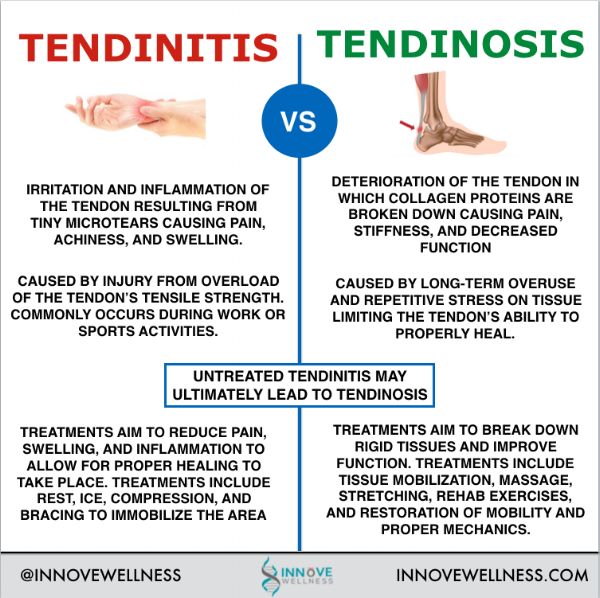Tendinitis vs. Tendinosis: Why It Matters
Previously, most tendon pain and damage was thought to be related to inflammation and all all of these injuries were given one name: tendinitis. Now we know that this is far from the case and most injuries to tendons are very different than previously thought.
Tendinopathy is a broad term which categorizes injuries to tendons, most importantly tendinitis and tendinosis. Although these conditions fall under the same category, they are vastly different in nature and require different treatment methods alleviate pain and restore function. When one type of tendinopathy is misdiagnosed for the other, the incorrect treatment may actually make the other condition worse.
TENDINITIS:
When you think of tendinitis you likely think of a condition consisting of burning pain that is made worse with activities. This is true as tendinitis results from an injury that causes micro-tears in the tendon leading to increased inflammation and pain.
Previously, the diagnosis of tendinitis was very widespread and included any injury and pain to a tendon. Looking back, we now know that this diagnosis has often been mistaken and many of the injuries diagnosed as tendinitis were actually tendinosis.
Although more rare, tendinitis still does occur but exhibits different symptoms, a different prognosis for recovery, and requires a completely different treatment. In fact, the goal of treatment for tendinitis is almost opposite that of tendinosis.
Treatment for tendinitis aims to reduce the inflammation and allow for healing to take place. With tendinitis, rest is key in order to decrease acute inflammation and allow for recovery. Common treatments of tendinitis include rest, ice, compression, and bracing to immobilize the joint. The prognosis and treatment time for tendinitis is shorter than that of tendinosis, as recovery can be seen as soon as a few days to 6 weeks.
Irritation and inflammation causing burning/sharp pain and swelling.
Caused by overload injury stronger than the tendon's tensile strength.
Injury commonly occurs during work or sports activities.
Treatments aim to reduce pain, swelling, inflammation, and to allow healing to occur.
Rest, ice, compression, and immobilization are common treatments.
Treatment time ranges from several days to 6 weeks.
TENDINOSIS:
Tendinosis differs from tendinitis in many important ways. As opposed to tendinitis, tendinosis is usually caused over a longer period of time due to repetitive movements causing chronic degeneration without the rest necessary for revery and healing; which leads to an injury that exhibits less inflammation.
The chronic nature of tendinosis often leads to thickening of the tendon which can create problems with associated structures. For example, tendinosis in the wrist can often exhibit carpal tunnel-like symptoms because the thickened tendon may squeeze the median nerve as it exits it's supporting structures.
While tendinitis creates inflammation in the tendon itself, tendinosis is marked by the degradation of a structural protein called collagen. This degradation causes the tendon to become more rigid and lose it's important function as a structure which provides stability and mobility, impacting the normal biomechanics of the joint and leading to further problems.
The treatment of tendinosis varies greatly from that of tendinitis. While the goal of tendinitis treatment is to reduce inflammation, the goal of treatment for tendinosis is to improve mobility, blood flow, and restore proper joint mechanics. Treatments for tendinosis include tissue mobilization, massage, stretching, rehab exercises, and restoration of mobility and proper mechanics. Treatment for tendinosis is usually much longer than that of tendinitis and the range varies greatly depending on how long the injury has been sustained, ranging from 6 weeks to 9 months.
Deterioration of the tendon due to long-term overuse and repetitive stress
Collagen proteins are broken down and degraded.
Deterioration causes pain, stiffness, and decreased function.
Treatment is aimed at breaking down rigid tissue to improve function.
Treatments include tissue mobilization, massage, stretching, rehab exercises, and restoration of mobility and proper mechanics.
Treatment time for tendinosis ranges from 6 weeks to 9 months.
THE BOTTOM LINE:
Understanding the difference between tendinitis and tendinosis is critical to proper management and treatment. Misdiagnosis and improper treatment can often lead to worsening of the condition if one is mistaken for another. It is important to work with a skilled healthcare provider who understands this difference and has experience diagnosing and treating both conditions.

